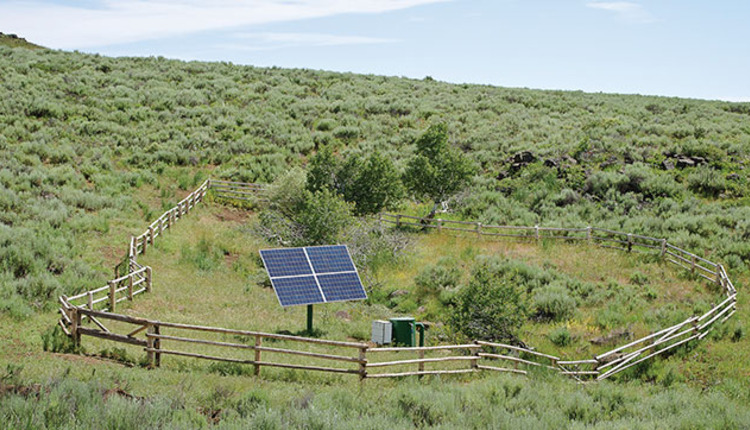
Cattle and other livestock have long shared the range with greater sage-grouse. However, as populations of the bird are diminishing across the West, ranchers are not standing idle. Instead, ranchers and other private landowners are entering into collaborative conservation partnerships with federal agencies and programs to conserve and improve vital habitat for these threatened upland birds.
Recent estimates show sage grouse have dropped in numbers over time from around 500,000 to less than 200,000 today, with the core of that population (around three-quarters) occupying just 27 percent of their original range. Currently, the bird makes its home on approximately 186 million acres across 11 states and two Canadian provinces in western North America. Nearly 40 percent of these lands in the U.S. are privately owned with many in agricultural use.
Moreover, research has shown a strong link between wetland areas and the distribution of sage grouse breeding areas, also known as leks. Studies revealed 85 percent of leks were clustered within 6 miles of wetland areas. These wet areas, called mesic habitat, are essential to sage grouse during nesting and brooding periods.
The Western landscape is covered by less than 2 percent of wetland habitat. Matters change, however, when it’s considered that more than 80 percent of these wet areas are also located on private lands.
If headway on sage grouse conservation is to be made, cooperative ventures between private landowners are vital to sustaining sage grouse habitat.
Partnerships develop
Groups like the Sage Grouse Initiative (SGI), a partnership project launched by the Natural Resource Conservation Service (NRCS) in 2010, are at the forefront of a proactive conservation effort. To date, the organization says it has helped 1,129 ranches conserve over 4.4 million acres of sage grouse habitat.
In 2010, Nevada rancher Tony Stobiecki partnered with SGI on his 3,000-acre Rockin’ TD Ranch near Vya to implement multiple conservation projects to develop better water access and open up more wildlife habitat across the property. These improvements included nearly a dozen spring developments and installation of off-site water tanks to keep cattle out of sensitive riparian areas. Removal of nearly 800 acres of encroaching juniper, plantings of native grasses and forbs, and a switch to prescribed grazing rounded out the list of projects.
Thanks to these efforts, numbers of sage grouse have grown quite a bit across the ranch, says Stobiecki. Consecutively, the hard work is also paying off in the pasture in the form of livestock grazing improvements.
“Before we purchased the property, the ranch appeared to be overgrazed by cattle, and as a result, negatively impacted the wildlife,” says Stobiecki. “Today, it has improved allowing the land to better support wildlife with proper grazing.”
Neil Helmick and his family in north central Idaho are also seeing the benefits of conserving sage grouse habitat. The family’s 4,000-acre ranch property near Hill City, which contains many meadow and wetland areas, lies within a few miles of a well-known lek where sage grouse mate each spring.
In 2013, when it was likely that sage grouse might be listed under the Endangered Species Act, Helmick chose to work with SGI’s range and wildlife conservationist Ed Contreras to ensure his lands and livelihood were protected.
Helmick’s first step was to adopt a prescribed grazing plan. He waits until June 15 to bring his cattle to the Hill City ranch to graze, keeping them on irrigated meadows for the first six weeks of the grazing season. Come early August, he moves cattle to upland pastures to graze.
Deferring grazing in upland areas across the ranch until August 1 allows sage grouse to use prime nesting and brooding habitat earlier in the summer. This practice also ensures adequate residual cover is left to provide nesting areas for the birds and that native grasses have time to reseed and re-establish.
“We’ve expanded the carrying capacity and grass production, which lets us leave more for the wildlife and run more cows,” says Helmick.
Other NRCS-funded projects to improve water access across the Helmick Ranch, such as a pipeline, spring development, solar pump, water storage tank, and off-site water tanks, have also enhanced grazing distribution and pasture utilization.
Stobiecki and Helmick are just two examples of land stewards among many others in the ranching community who are making a difference for sage grouse and other wildlife through proactive conservation efforts.
This article appeared in the November 2016 issue of Hay & Forage Grower on page 16.
Not a subscriber? Click to get the print magazine.

